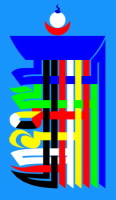
|
Christopher John Fynn The Ranjana script is found in many Buddhist Sanskrit manuscripts from India and Nepal and it is still used by the Newari community (the original inhabitants of the Kathmandu valley) for their religious texts both Hindu and Buddhist - and for some other writings in Sanskrit and Newari. I think a form of Ranjana was widely used for writing Newari until the 20th century but it has fallen out of use because of the unavailability of printing types in this script (and it because it is probably unsuitable for printing at small sizes). Tibetans use this script, which they call lanydza, particularly for writing the Sanskrit titles of books which have been translated from Sanskrit to Tibetan. They also use it for writing decorative script in temples, bija mantras in mandalas and there are a few texts printed with alternating lines in Sanskrit using this script followed by a Tibetan translation in Tibetan script. There were many original Sanskrit manuscripts written in this script preserved in the old monasteries of Tibet but unfortunately most of these were destroyed following the take-over of that country by the Communist Chinese - though reportedly a number were taken to Beijing and are still held there. There is a Nepal-German manuscript project which is preserving and cataloguing many manuscripts in this script held in Nepal. I have also seen manuscripts in this script in the museum at Patna, Bihar and in the British Library - there must be a number of others in the Asiatic Society Library in Calcutta and other places. There is another similar script which Tibetans call Vartu that is more or less a headless form of the Ranjana / Lanydza script. Ranjana is also closely related to the Siddham script used in Japan. from a note by him - Yashwant. Images:
 . |